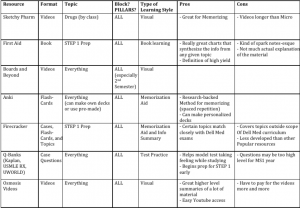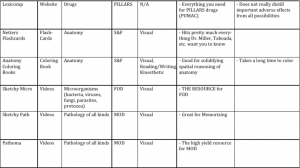Below is an attempt to provide guidance and direction as MS1’s decide what resources will work best for them. The page is organized by resources that can be used throughout the year followed by block specific recommendations. If it’s on here, people use it. See the bottom of the page for a chart that condenses this information.
QUICK NOTE: before you buy anything, make sure to chat with a friendly neighborhood MS2 or MS3! We would love to share our perspective.
Year-Long Resources (in no particular order):
Sketchy Pharm — Sketchy videos are illustrations put into narrated cartoon video form to help you memorize facts. Sketchy has videos for Pharmacology, Microbiology, and Pathology. Each Pharm video takes on a specific class of drugs to explain the mechanism of action, significant adverse reactions or drug interactions, and any other information that might show up on tests or STEP exams. If you are a visual learner and images help you remember facts, it does not get much better than Sketchy. Some videos are better than others of course, but the biggest complaint against Sketchy Pharm is that the videos are too long and sometimes try to cram in too much information. Others swear by the videos, so definitely try some as you start to learn drugs — there is a free trial available.
(***Note: the image from the top of this page is from a Sketchy party the inaugural class had where they dressed up as Sketchy characters…that’s how much we love Sketchy, especially Micro, as discussed below for FOD)
First Aid — First Aid is widely known as THE definitive summary guide for STEP 1. It is like STEP 1 spark notes. If it’s in the book, you should know it if you are trying to ace the test. For students who are all about super high yield (SHY), First Aid is a great reference. Some students use it religiously, and a lot of students find it useful as a good condensed summary for studying at the end of blocks.
Boards and Beyond — Boards and Beyond is a series of videos will teach you basically everything you need to know – the cardiologist behind it essentially teaches all of the material in First Aid in his videos. His videos cover physiology, pharmacology, and pathology for all of the organ systems, and he also has lectures on biochemistry, infectious disease, and biostatistics. He also includes helpful clinical pearls for your rotations in many of the videos. A number of students use these videos religiously and either started watching them when MS1 year started or wished they had for LGI prep and for PILLARS cases. The negative feedback you hear typically involve the videos being dry and a little boring, but many people love them.
Anki — Anki is a flashcard, spaced-repetition-based study tool. The link provided gives a description of Anki, links for downloading the application on your laptop, free downloads for popular pre-made Anki decks (Zanki is popular…so is Pepper), and an additional ranking of medical school resources if anyone is skeptical of this page! Anki is an evidence-backed successful tool for studying for STEP, so many of our classmates will vouch for it. And many classmates found this individual medical student’s website that provides detailed discussions and suggestions of how to maximize the utility of Anki helpful as well (one of his pages provides a 3rd ranking system of outside resources to check out).
Firecracker — Firecracker is a study tool for the STEP exams. The website (there is also a smartphone app) has summaries of topics, flashcards, and case questions for material covered in lecture and beyond. It’s like an interactive First Aid. Study tools include daily flashcards (that most people don’t really like) and randomly-generated case questions that mimic test questions. The actual tests and competency checks you will take during the MS1 year are actually given through the Firecracker website, so the case questions in particular are quite useful in mirroring questions that might appear on Dell Med exams and comp checks. The biggest complaint against Firecracker is that there is information covered on Firecracker that we are not expected to know for our specific Dell Med curriculum. How much of this info there is beyond the scope of our specific classes varies widely by topics, but the extra information can be distracting at times.
Question Banks — Outside of Firecracker, there are other Question Banks or Q-Banks that are designed to replicate the types of questions you might see on STEP 1 or shelf exams during rotations. As a result, these resources are often utilized during the MS2 year, but some students like to start using them right away. The most popular Q-Banks are Kaplan Q-Bank, USMLE RX, and UWORLD. These services generate quizzes based on specific topics, and after you submit your answers, they provide full explanations of why the correct answer is correct and why the incorrect answers are incorrect — a great tool for studying. Kaplan and USMLE RX are relatively popular during the first year because many students feel like Firecracker (which we have free access to) tends to align less with board material. USMLE RX is particularly known for being closely tied to First Aid material, and Kaplan is known for being particularly specific and difficult. Once students get closer to STEP 1 (so during our MS2 year), students often transition to UWORLD — it’s known as the best Q-Bank. Students get discounts on many of these test prep materials by becoming an AMA student member (our AMA rep wrote this one…classic) or by using promo codes available around the holidays. Again, many students will wait until Year 2 to start using these question banks, but feel free to get ahead of the game if you have some extra time!
Osmosis Videos — Osmosis videos are YouTube videos that cover a lot of the topics that you will see in medical school. Students mainly like to use these videos as either starting points or review material because they are not quite to the depth that we need for tests or PILLARS, but they do a good job of capturing the gestalt of various topics. Most of the videos are free, but some require a subscription. I do not know anyone who has subscribed though, so that might tell you something.
PILLARS Resources:
Genetics Home Reference — Use this website for genetics related LOs for C2P PILLARS cases (there are a lot of them). Other blocks have PILLARS cases with genetics stuff too, but those are much less common. GHR is an NIH website and normally comes up pretty easily on a simple google search, but it is just a great website that will give you exactly what you need to know about the genetic condition most of the time.
Nature Disease Primers (or JAMA, NEJM, or The Lancet Systematic Reviews) — If a Nature disease primer exists for a case, it will basically serve the case up for you on a silver platter. It is never a bad idea to check to see if this exists — unfortunately, they won’t exist for every case. It likely will have more detail than you need about a couple of the case topics, but they also won’t miss much (beyond biopsychosocial LOs, potentially). JAMA, NEJM, or The Lancet recent systematic reviews will serve a similar function.
Robbins Pathologic Basis of Disease — While Robbins is intimidating due to its size (unless you’re using the electronic version or Basic Pathology edition), Robbin’s is a solid go-to starting source for PILLARS case research, especially later on in the year (MOD is basically a class spent working through all of Robbins). The book has clear explanations about the pathology of most diseases, an appropriate level of mechanistic detail, and excellent figures for 85-90% of cases. Available on Clinical Key. And here is the Basic Pathology edition, also through Clinical Key. Also a recommended text for MOD.
Harrison’s Internal Medicine — While Robbins is a good first stop for understanding the pathophysiology of disease, Harrison’s is an excellent resource for clinical management . It has great pathophysiology and clinical applications too (especially for conditions with less coverage in Robbins), but the figures aren’t as strong as Robbins. However, the flowcharts for clinical management are useful in the second semester when those components of PILLARS cases become more relevant. Available on Access Medicine.
Goldman-Cecil Medicine — Goldman-Cecil is pretty much an alternative to Harrison’s. Accomplishes the same task, but some people like Goldman-Cecil more. Seems to be a preference thing (e.g., some students like the Clinical Key interface more than AccessMedicine). Available on Clinical Key.
Specialty-Specific Textbooks on AccessMedicine or Clinical Key — Specialty-specific textbooks are great for getting that extra bit more detail and explanation for specific conditions and diseases than Harrisons or Goldman-Cecil. Sometimes, especially for conditions that are not well understood, these specialty journals are necessary to get more than hand-wavy explanations for etiology, pathophysiology, etc. Similar to Nature, NEJM, JAMA, and The Lancet, these will be more detailed, so they might give you more detail than is absolutely necessary.
American Family Physician Journal — This journal has wonderful differential tables and work-up flowcharts for common presentations that are really good to talk through if you have those kinds of LOs, which will be common later in the year during MOD. The articles will often spend some time explaining clinical reasoning and tests, and sometimes that will give more detail than is necessary. Because of that, many students will go here just to grab the flowcharts and differential tables for their notes. The website will give you a link to a more recent article of theirs on that same topic if it exists, which is awesome because it ensures you have the most recent info about that topic.
PILLARS Drug Research — Lexicomp is likely the website most widely used. Clinical Key also has a good summary of the drug information you need to know if you just search the drug. There are also smartphone apps that many DOCS mentors and medical students recommend for the wards — Epocrates comes up most frequently. All of these resources will give you the major elements you need to know (PUMAC: pharmacokinetics, uses, mechanism of action, adverse effects, and cost). The hardest thing to figure out is often what the most relevant / testable / important adverse effects are because these websites often list every possible side effect. Good RX is a good website for looking into the cost of drugs in a way that is easier to understand.
Structure and Function Resources:
Netters Anatomy Flashcards — Netters textbook (Available through Clinical Key) was not our official assigned textbook, but Dr. Miller used the Netters pictures in lecture because they are extremely clear and well labeled. The Flashcards (around $40 on Amazon at the time of writing this) provide an organized and effective studying and quizzing tool for anatomy. If the textbook readings feel too dense and overwhelming, many students simply used the Flashcards instead because you can rest assured that all of the information on the back of the Flashcards is useful to know for our Dell Med exams — that is not always true of the full textbook readings.
U of M Anatomy Website — The University of Michigan Medical School has Online Modules that include dissection pictures, anatomy quizzes, and clinical vignettes. I wish I’d found this site sooner – it was super helpful to review for the lab practical. It would also be great for previewing the hit lists or reviewing right after lab.
Anatomy Coloring Books — Anatomy coloring books are useful for students who like a combination of visual, reading/writing, and kinesthetic learning styles. They are basically adult coloring books for anatomical structures. Both Kaplan and Netter’s produce coloring books. The Kaplan book is nice because it allows the student to try to label structures as you color, while Netter’s is organized more like a flash card. Some students find coloring and labeling structures more helpful than just looking at flashcards for learning the exact location and name of each structure, but the downside is that the learning process is more time-intensive.
Head Neck Brain Spine Website — Great website recommended by our superstar Radiologist, Dr. Jorge Taboada. Really good tool for studying the radiological aspects of the Structure and Function lecture and lab curricula. Tools available for quizzing yourself on all of the different sections of the body on X-ray, MRI, etc.
Blue Boxes in Gilroy’s Clinical Anatomy — Many students will tell you that you don’t need a textbook to learn anatomy because you’ll learn it in the lab and with repetition (i.e. flashcards), and that’s a fair point. However, make sure to ALWAYS read the blue boxes on Clinical Applications in the Gilroy’s readings — not only do they make the anatomy more memorable, but they’re extremely testable and therefore definitely worth the time. They distill down the important congenital defects, injuries, or disease processes related to the specific anatomy you will cover in that reading. Gilroy is not available electronically through UT library resources.
Foundations of Disease Resources:
Sketch Micro — Sketchy Micro is the same concept as Sketchy Pharm except the videos take on microorganisms (bacteria, viruses, fungi, parasites, and protozoa) instead of drugs. The biggest difference between the two is that basically EVERYONE LOVES SKETCHY MICRO. The videos are much shorter on average, and they give you great ways to memorize the key facts for distinguishing organisms and explaining the conditions they cause. Use Sketchy Micro in FOD. It will serve you well. (I literally thought about bolding this entire description to convince people to use this, but I thought that would be excessive)
Mechanisms of Disease Resources:
Sketchy Pathology — Sketchy Pathology is the same concept as Pharm and Micro, but with explanations of the pathology of various conditions. Less popular that Pharm and Micro, but some people still use it.
Pathoma — Pathoma is a video resource for pathology (i.e. Mechanisms of Disease). It covers all of the major diseases and conditions that we study in fairly quick videos. The illustrations that Dr. Sattar draws are very basic, but incredibly useful for retaining information. While Pathoma is not as in depth as some of the other resources, it is widely recognized as the most high yield for this topic of the pre-clinical part of medical school. There have been Competency Check questions seemingly directly from Pathoma, and First Aid lists it as an A+ resource for pathology. And at $120 for 21 months, it is fairly cheap — and that $120 includes a thin, paperback textbook that a lot of students will annotate while watching the videos.
Resource Chart (this link provides a PDF version):



Leave a comment below with your experience and recommendations.

This is a good How-To guide if you’ve never used Anki before and are starting early. — https://medshamim.com/med/anki-step-one